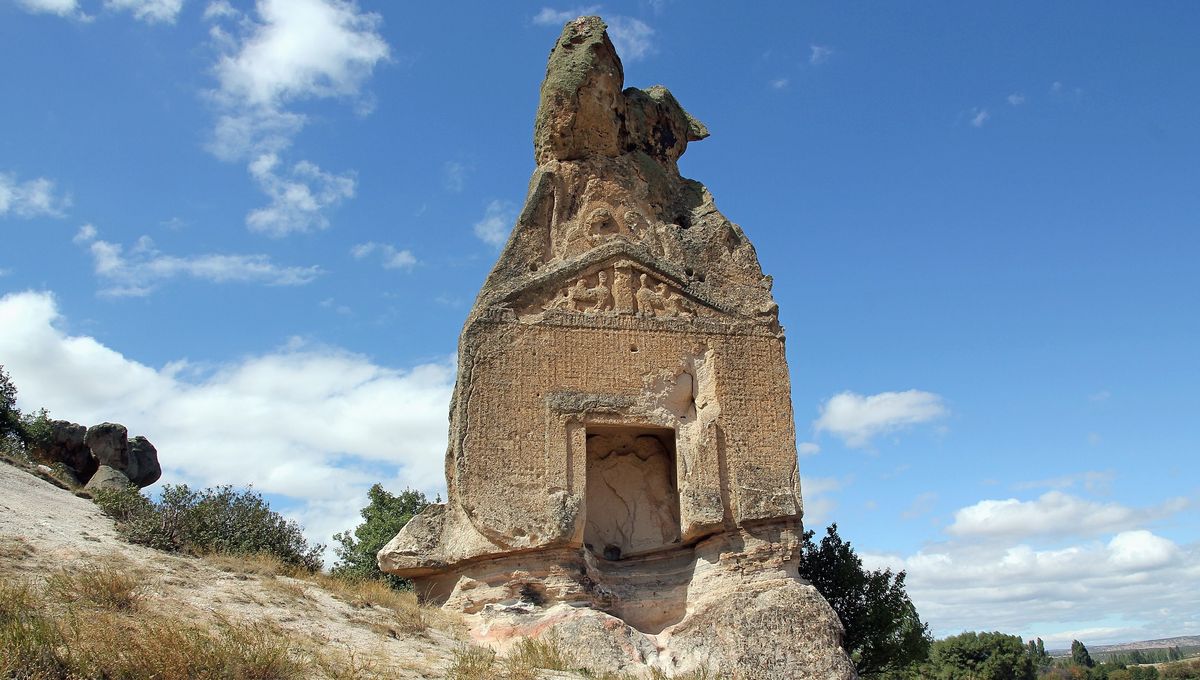
A new paper has confirmed and refined an inscription long thought impossible to pin down – and it seems to be a dedication to an ancient Mother goddess.
For 2,600 years, a lonely statue has stood at the south edge of a small valley in the midwest of Turkey. Known as Arslan (or Aslan) Kaya, the “Lion Rock” has been damaged to the point of illegibility: its sandstone base is eroding; its faces, originally adorned with carved sphinxes, lions, and goddesses, have been worn down by centuries of exposure to the elements; and the door and ornamental flourishes have fallen to modern treasure seekers armed with dynamite.
At the base of the monument, there’s an inscription. It’s written in “tall narrow Phrygian characters,” recorded William Mitchel Ramsay, the archeologist who first described Arslan Kaya in 1884, which are “not decipherable at the distance from which a spectator who has no ladder must contemplate it.”
For a spectator who did have a ladder, the situation was not much better. “The inscription is hopelessly obliterated,” Ramsay later reported, presumably from slightly higher up.
While a few investigators tried their hand at reading it over the years, Ramsay has mostly been proven correct: the general consensus is that the inscription probably says μ . τματερα, but it kind of depends on when and how you look at it as to what you’ll see exactly.
“Much depends upon the favorability of the light when photographs are taken,” wrote Mark Munn, a Professor of Ancient Greek History and Archaeology at Penn State and author of the new paper.
“Fortuitous timing of a recent visit to Arslan Kaya allowed me to take photographs that reveal these traces,” he noted, “and they are the occasion for this report.”
So, by taking his own photos and comparing them to the best ones collected by previous researchers, Munn set out to pin down precisely which letters had been carved all those years ago.
The result, he believes, is a dedication to “Materan” – “the name or title of the goddess, Matar (Mother) in the accusative case,” the paper explains. “This can be understood as a reference to the image that once appeared in the niche directly below her name.”
That, by the way, is noteworthy. Arslan Kaya is far from the only reference we have of this mysterious Mother goddess from ancient Phrygia, but it is nevertheless unique: “None of the larger ones actually had a standing image of the Mother carved in them,” Munn told ArtNet, “although probably movable statues were placed there.”
“Arlsan Kaya is unique in that it is (or was) the only Phrygian monument with an image of the Mother and with an inscription naming her,” he said.
Based on those other examples of Phrygian monuments, it’s likely the name was once part of a longer inscription, Munn suggested in his paper – one which recorded who originally erected the monument, and bestowed the goddess with an epithet. That would follow with the so-called Areyastis monument, around 40 kilometers to the southwest of Arslan Kaya, where the deity is referred to as “materan areyastin”.
What that latter word means exactly is unclear – and frankly, that’s part of why people are interested in these inscriptions. “The [Phrygian] language is not well understood,” Munn told ArtNet, “so any new evidence is of interest to scholars of ancient Anatolian languages and cultures.”
The paper is published in the journal Kadmos.
Source Link: "Hopelessly Obliterated”: Ancient Inscription In Lost Language Finally Deciphered